Achieving Purity: A Dust-Free and Allergen-Optimized Home
Posted on 01/10/2025
Achieving Purity: A Dust-Free and Allergen-Optimized Home
Is your home as pure and healthy as you wish it were? Every day, invisible threats like dust and allergens diminish your indoor air quality and, as a result, your well-being. Achieving a truly dust-free and allergen-optimized home is a goal worth pursuing--not just for cleaner surfaces, but for the overall health and comfort of everyone who lives there.
In this comprehensive, Google-friendly guide, we'll break down actionable strategies, advanced solutions, and expert recommendations to minimize dust, banish allergens, and ensure your house is as clean and healthy as possible. Here's how you can transform your environment into an oasis of purity.
Understanding the Importance of a Cleaner, Purified Environment
Why is it crucial to strive for a low-allergen, dustless space?
- Improved health and well-being: Less exposure to dust and allergens means fewer allergic reactions, respiratory problems, and less stress on the body.
- Enhanced aesthetics: Dust-free surfaces look better, feel better, and make your home more inviting.
- Home preservation: Reducing dust also helps preserve electronics, fabrics, and furniture, extending their lifespan.
Whether you have asthma, allergies, or are simply aiming for fresher air, making your home a clean air sanctuary benefits everyone.

What Causes Dust and Allergens to Accumulate?
To achieve purity in your home, you first need to know where dust and allergens come from. Many common culprits include:
- Outdoor particles brought in on clothing and shoes
- Pet dander from cats, dogs, and other animals
- Dust mites thriving in carpets, bedding, and upholstery
- Pollen entering through windows and doors
- Mold spores from damp areas
- Textiles and fibers breaking down from furniture, clothing, and curtains
Understanding these sources helps you target them with precision.
Strategies for Achieving a Dust-Free and Allergen-Optimized Home
1. Master the Art of Effective Cleaning
The key to a dust-free and allergy-reduced home is consistency. Here's how to clean smarter for maximum results:
-
Vacuum regularly with HEPA filtration:
- Use a vacuum equipped with a HEPA (High-Efficiency Particulate Air) filter to trap even microscopic particles.
- Vacuum floors, upholstery, and drapes at least twice a week.
-
Damp-dust surfaces:
- Use a slightly damp microfiber cloth instead of dry dusting, which can simply scatter dust into the air.
- Pay extra attention to shelves, baseboards, and electronic devices.
-
Wash bedding often:
- Hot water kills dust mites, so wash sheets and pillowcases every week in water at 130?F (54?C) or hotter.
Don't forget: Clean your cleaning tools (like vacuum filters and mop heads) regularly to avoid redistributing dust and allergens.
2. Create an Allergen-Resistant Environment
Optimizing your home for minimal allergy exposure requires a proactive mindset:
-
Reduce textiles:
- Carpets, rugs, and heavy drapes are dust traps. Opt for easy-to-clean flooring such as hardwood or tile and use washable curtains or blinds.
-
Encase mattresses and pillows:
- Use dust-mite-proof covers made of tightly woven fabric to block allergens from accumulating inside bedding.
-
Limit clutter:
- Clutter collects dust. Store items in closed containers and regularly declutter shelves and surfaces.
-
Pet management:
- Keep pets groomed and off beds. Consider creating pet-free zones, especially in sleeping areas.
3. Optimize Air Quality for Allergen-Free Living
Clean air is central to a purified household. Here's what you can do:
-
Install high-quality air purifiers:
- Use HEPA-equipped or activated carbon filter purifiers in bedrooms and living areas to trap dust, pollen, pet dander, and volatile organic compounds (VOCs).
-
Change HVAC filters:
- Replace filters every 1-3 months, and consider using allergy-specific filters for best results.
-
Control humidity:
- Dust mites and mold thrive in moist settings. Use dehumidifiers to keep indoor humidity between 30-50%.
-
Ventilate wisely:
- Ventilate with filtered, clean air. Avoid opening windows during high pollen or pollution days; instead, use mechanical ventilation with good filters when possible.
Optimizing indoor air quality is often the most impactful step toward achieving a low-allergen living space.
4. Target High-Risk Zones in Your Home
Not all rooms are equally prone to dust and allergens. Focus on these critical areas:
-
Bedrooms:
- Bedding, carpets, and drapes are dust-mite havens. Use allergen-proof bedding, keep floors bare, and launder fabrics regularly.
-
Living rooms:
- Upholstered furniture and electronics (which attract static and dust) need frequent cleaning.
-
Entryways:
- Stop allergens at the door by using doormats, removing shoes, and regular sweeping or mopping.
-
Bathrooms and basements:
- Prevent mold with proper ventilation, fix leaks, and clean tiles regularly.
5. Choose Cleaning Products Carefully
Some cleaning solutions themselves can irritate allergies. Opt for:
- Hypoallergenic and fragrance-free options
- Non-toxic, eco-friendly cleaners (such as vinegar and baking soda)
- Products certified for asthma and allergy safety
Always test new products in small areas, and ensure the room is well-ventilated during cleaning.
Advanced Tips for a Supremely Allergen-Optimized Home
Invest in Smart Technology
-
Robotic vacuums with HEPA filters:
- These devices can clean floors daily, ensuring a steady reduction in dust buildup.
-
Air quality monitors:
- Track real-time levels of dust, pollen, and volatile compounds to optimize ventilation and purification.
-
Smart thermostats and humidistats:
- Automate humidity and temperature settings for optimal dust and allergen control.
Design Choices to Enhance Dust and Allergen Purity
- Choose minimalistic, easy-to-clean furniture such as leather or vinyl instead of plush upholstery.
- Avoid heavy drapes and opt for blinds that can be wiped clean easily.
- Install central vacuum systems which vent exhaust outdoors for superior dust removal.
- Use sealed, smooth flooring like tile, hardwood, or linoleum.
Establish Allergen-Proof Home Habits
- Shower and change clothes after coming indoors, especially during pollen-heavy seasons.
- Groom pets outside and wash their paws before they come in.
- Don't allow smoking indoors, as it's a major source of airborne particles and irritants.
- Wash hands regularly to avoid transferring dust and allergens to furniture and fabrics.
Common Mistakes That Sabotage Purity and Allergen Control
In the quest for a dust-free environment, avoid these common pitfalls:
- Neglecting filters: Dirty air filters recirculate dust rather than filter it out.
- Overlooking hidden surfaces: Ceiling fans, lampshades, and behind furniture accumulate surprising quantities of dust.
- Ignoring regular maintenance: Erratic cleaning practices allow dust and allergens to build up quickly.
- Relying on "air fresheners": Many simply mask odors and may add chemicals, rather than removing dust and allergens.
Addressing these oversights brings you closer to total home purification.
The Role of Professional Help
Sometimes, achieving a truly dustless and allergen-free home requires expert intervention:
- Professional deep cleaning: Schedule a deep clean at least once or twice a year to handle carpets, drapes, and HVAC systems.
- HVAC maintenance technicians: Ensure ductwork and systems are free from dust, mold, and contaminants.
- Environmental consultants: For severe allergy cases, professionals can assess sources of contamination and recommend advanced solutions.

Frequently Asked Questions (FAQs)
How quickly will I notice improvements in air quality?
Results may be noticeable within days, especially after thorough cleaning and introducing a HEPA air purifier. Allergy symptoms may decrease as triggers are removed.
Should I remove all carpeting to optimize my home for purity?
While not mandatory, eliminating wall-to-wall carpet in favor of hard flooring can drastically reduce dust mites and allergens.
Can plants help purify indoor air?
Certain houseplants can absorb some air pollutants, but they may also harbor mold in their soil. Consider this before introducing plants into highly allergen-sensitive homes.
What's the best way to keep dust from coming back so quickly?
Preventative measures--like changing air filters, using doormats, and regular cleaning with HEPA tools--are key for long-term purity.
Conclusion: Transforming Your Home Into a Purity Haven
Achieving a dust-free and allergen-optimized home is an ongoing journey, not a one-time event.
- Stay consistent with effective cleaning routines.
- Embrace allergen-resistant design and smart technology.
- Focus on high-risk zones and keep up good habits.
Remember, the payoff is enormous: Enhanced health and comfort, longer-lasting possessions, and a peaceful, purified environment worth cherishing. Start your transformation today--and breathe easier in your allergy-optimized, dust-free sanctuary!




